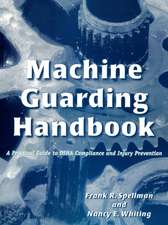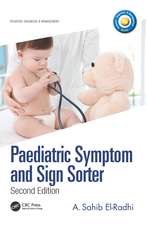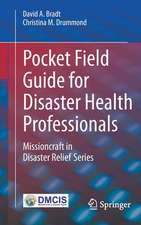The Clinical Interview: Skills for More Effective Patient Encounters
Autor Scott Simpson, Anna McDowellen Limba Engleză Paperback – 16 iul 2019
This book describes brief skills and techniques for clinical providers to improve their patient interactions. Although evidence-based psychotherapies are typically designed for longer specialized treatments, elements of these psychotherapies can help clinicians obtain better patient histories, develop more effective treatment plans, and more capably handle anxiety-provoking interactions. Each chapter is brief and easily digestible, contains sample clinical dialogue, and provides references for further reading. These skills help clinicians practice more effectively, more efficiently, and with greater resilience. Whatever your clinical specialty or role, whether you are a trainee or an experienced clinician, The Clinical Interview offers practical wisdom and an entirely new way to think about the clinical encounter.
The Clinical Interview will be of great use to any student in a health-related field of study or a healthcare professional interested in refining their interviewing skills. It will help anyone from emergency medical technicians, nurses, and physician assistants, to nurse practitioners and physicians to build more meaningful patient relationships.
| Toate formatele și edițiile | Preț | Express |
|---|---|---|
| Paperback (1) | 220.78 lei 6-8 săpt. | |
| Taylor & Francis – 16 iul 2019 | 220.78 lei 6-8 săpt. | |
| Hardback (1) | 968.66 lei 6-8 săpt. | |
| Taylor & Francis – 15 iul 2019 | 968.66 lei 6-8 săpt. |
Preț: 220.78 lei
Preț vechi: 232.41 lei
-5% Nou
Puncte Express: 331
Preț estimativ în valută:
42.25€ • 43.78$ • 35.26£
42.25€ • 43.78$ • 35.26£
Carte tipărită la comandă
Livrare economică 21 martie-04 aprilie
Preluare comenzi: 021 569.72.76
Specificații
ISBN-13: 9781138346505
ISBN-10: 1138346500
Pagini: 214
Ilustrații: 63 Line drawings, black and white; 9 Tables, black and white; 63 Illustrations, black and white
Dimensiuni: 152 x 229 x 15 mm
Greutate: 0.32 kg
Ediția:1
Editura: Taylor & Francis
Colecția Routledge
Locul publicării:Oxford, United Kingdom
ISBN-10: 1138346500
Pagini: 214
Ilustrații: 63 Line drawings, black and white; 9 Tables, black and white; 63 Illustrations, black and white
Dimensiuni: 152 x 229 x 15 mm
Greutate: 0.32 kg
Ediția:1
Editura: Taylor & Francis
Colecția Routledge
Locul publicării:Oxford, United Kingdom
Public țintă
ProfessionalCuprins
SECTION I. BUILDING RAPPORT
1. Elicit one goal
Be more efficient by learning the patient’s agenda
2. Validate three different ways
Be authentic in your validation by expanding the ways in which you can agree with the patient
3. Mirror the patient’s language to build rapport
Use the patient’s phrasing to avoid misinterpretation
Jodi Zik, MD
4. Use the power of "and"
Introduce "and" rather than "or/but" statements to your interview to establish rapport, validate the patient’s experience, and facilitate change
Ashley Curry, MD
5. Redirect demanding patients
Reinforce that the patient, like everyone, is entitled to good medical care
6. Be silent
Use active silence to support the patient’s emotional expression
Jesse Markman, MD, MBA
7. Be playful
Introduce playful irreverence to challenge rigidity, signal affection, and build social connection
Amy Dowell, MD, and Alexia Giblin, PhD, CEDS
8. Handle the hollering with a calming question
Through tone of voice, active listening, and setting limits, invite a conversation to de-escalate a shouting patient
Thomas Dunn, PhD
9. Recognize your own emotions
Identify and process your countertransference during the interview to improve the patient’s well-being (and your own)
Jonathan Buchholz, MD, Lionel Perez, MD, Lindsay Lebin, MD, and Heidi Combs, MD, MS
10. Reflect the patient’s statements
Use a well-timed reflection to disrupt a negative thought spiral
Jesse Markman, MD, MBA
11. Introduce progressive muscle relaxation
Give the patient an active task to change their emotional experience
Jesse Markman, MD, MBA
12. Use emotional validation to manage negative countertransference
Disarm your negative emotions and humanize your patients
Melanie Rylander, MD
13. Consider fear when the patient is angry
Assess what the patient might be afraid of when they become upset
14. Validate the patient’s perspective of where they are now and where they need to go
Understand and support the patient’s reality and goals to enhance motivation for treatment
15. Share how you feel
Put your own feelings into words to reset a difficult conversation
16. Agree to disagree
De-escalate an argument by repeating this short phrase
17. Be honest about your limitations
Relieve yourself of unobtainable expectations and reset the conflictual encounter
SECTION II. TAKING A HISTORY
18. Be curious
When curious about what a patient has said, ask more questions to obtain useful information and show the patient that you are interested
Rachel Glick, MD
19. Prioritize information you need right now
Shift your line of questioning without shifting the topic
David Kroll, MD
20. Use open-ended questions for sensitive topics
Invite greater honesty and avoid a sense of judgment through open-ended questions
21. Attend to affect
Emphasize the patient’s emotional words for a richer history
22. Validate and move
Use validation as a transitional tool in the unwieldy interview
23. Write a timeline
Organize chaotic histories and validate the patient’s experience
24. Ask "How come?" instead of "Why?"
Vary your phrasing slightly to improve the tone of the interview
25. Observe caregivers’ nonverbal cues
Gather information from caregivers to increase accuracy and efficiency in diagnosis of cognitive disorders
Joleen Sussman, PhD, ABPP
26. Roll with impaired reality testing
Provide a validating and grounded interview for patients with psychotic symptoms
Erin O’Flaherty, MD
27. Ask for help understanding
Frame an open-ended question as a plea for the patient’s assistance
28. Collect the social history first
Re-order the traditional interview to better engage reluctant patients
Sarah Schrauben, MD
29. Ask about family history
Use the family history as a lead-in to sensitive questions
30. Wonder aloud with the patient
Use and re-use a brief, non-committal phrase to explore the patient’s history and treatment options
SECTION III. MAKING AN ASSESSMENT
31. Track symptoms and behaviors
Keep a log to aid diagnosis and begin treatment
32. Find the key worry
Consider the anxious patient’s most important worry in making the diagnosis
33. Consider past healthcare encounters
Ask how patients’ past healthcare experiences may inform their current experience
34. Identify what is solvable
Focus on concrete objectives that you and the patient can realistically solve together
35. Talk about traits, not diagnosis
Think of maladaptive thoughts and behaviors on a spectrum of normal
Jodi Zik, MD, and Melanie Rylander, MD
36. Label the patient’s affect
Help manage the patient’s emotional experiences by putting it into words
Edward MacPhee, MD
37. Talk about the mind-body connection
Connect psychiatric and medical symptoms to encourage openness to mental health interventions
Thida Thant, MD
38. Emphasize function over feeling in chronic illness
Shift the visit’s focus to capability to reinforce the patient’s self-efficacy and agree on achievable outcomes
39. Consider the social history in your assessment
Apply the social history as a tool for understanding the patient’s diagnosis and treatment
Jodi Zik, MD
40. Remind the patient what is not working
Ask how the patient feels about their current behaviors in order to motivate change
41. Ask about medication side effects
Assess experiences of side effects when medications are seemingly ineffective
Vivian Cheng, PharmD, and Jeffrey Clark, PharmD, BCPP
42. Ask the "why" about online information
Focus on the patient’s motivations for sharing information brought to the encounter
43. Recall the patient’s strengths
Consider how the patient’s abilities can be used in the service of their health
44. Accept or change
Simplify the possible outcomes to help the patient stop venting and decide on action
SECTION IV: PLANNING TREATMENT
45. Set the stage
Spend one visit preparing to make significant treatment changes
46. Fish for change talk
Guide the patient into talking about behavior change more quickly
Alex Kipp, MD, MALS
47. Imagine the future
Envision the patient’s healthy life in order to prioritize treatment goals
48. Prescribe change
Use a prescription pad to emphasize non-pharmacologic interventions
49. Ask the patient’s beliefs regarding medications
Understand what patients think medications will do for them to clarify treatment and improve adherence
50. Anticipate challenges
Be specific in planning ahead and removing obstacles to treatment success
51. Experiment with change
Introduce change as something the patient can simply try out—no commitment necessary!
52. Operationalize improvement
Be specific with the patient about what "better" means
53. Frame limit-setting from the patient’s perspective
Consider how setting effective limits will improve the patient’s care
David Kroll, MD
54. Share difficult decisions
Give the patient options when collaborating on a treatment plan with which the patient is reluctant to engage
55. Define efficacy for medication changes
Understand the patient’s goals and how they will know if a medication change is working
56. Help patients resist urges
Review how patients can refrain from acting on unhelpful impulses
57. Accept ambivalence: "It’s okay not to change"
Allow patients to acknowledge and accept when they are not ready to change
Jodi Zik, MD, and Melanie Rylander, MD
58. Plan for a crisis
Write a three-step crisis plan to anticipate patients’ triggers and coping skills
59. Normalize challenges
Validate that treatment is difficult for many patients
60. Reinforce the positive
Encourage healthy decision-making and adherence with plentiful encouragement
1. Elicit one goal
Be more efficient by learning the patient’s agenda
2. Validate three different ways
Be authentic in your validation by expanding the ways in which you can agree with the patient
3. Mirror the patient’s language to build rapport
Use the patient’s phrasing to avoid misinterpretation
Jodi Zik, MD
4. Use the power of "and"
Introduce "and" rather than "or/but" statements to your interview to establish rapport, validate the patient’s experience, and facilitate change
Ashley Curry, MD
5. Redirect demanding patients
Reinforce that the patient, like everyone, is entitled to good medical care
6. Be silent
Use active silence to support the patient’s emotional expression
Jesse Markman, MD, MBA
7. Be playful
Introduce playful irreverence to challenge rigidity, signal affection, and build social connection
Amy Dowell, MD, and Alexia Giblin, PhD, CEDS
8. Handle the hollering with a calming question
Through tone of voice, active listening, and setting limits, invite a conversation to de-escalate a shouting patient
Thomas Dunn, PhD
9. Recognize your own emotions
Identify and process your countertransference during the interview to improve the patient’s well-being (and your own)
Jonathan Buchholz, MD, Lionel Perez, MD, Lindsay Lebin, MD, and Heidi Combs, MD, MS
10. Reflect the patient’s statements
Use a well-timed reflection to disrupt a negative thought spiral
Jesse Markman, MD, MBA
11. Introduce progressive muscle relaxation
Give the patient an active task to change their emotional experience
Jesse Markman, MD, MBA
12. Use emotional validation to manage negative countertransference
Disarm your negative emotions and humanize your patients
Melanie Rylander, MD
13. Consider fear when the patient is angry
Assess what the patient might be afraid of when they become upset
14. Validate the patient’s perspective of where they are now and where they need to go
Understand and support the patient’s reality and goals to enhance motivation for treatment
15. Share how you feel
Put your own feelings into words to reset a difficult conversation
16. Agree to disagree
De-escalate an argument by repeating this short phrase
17. Be honest about your limitations
Relieve yourself of unobtainable expectations and reset the conflictual encounter
SECTION II. TAKING A HISTORY
18. Be curious
When curious about what a patient has said, ask more questions to obtain useful information and show the patient that you are interested
Rachel Glick, MD
19. Prioritize information you need right now
Shift your line of questioning without shifting the topic
David Kroll, MD
20. Use open-ended questions for sensitive topics
Invite greater honesty and avoid a sense of judgment through open-ended questions
21. Attend to affect
Emphasize the patient’s emotional words for a richer history
22. Validate and move
Use validation as a transitional tool in the unwieldy interview
23. Write a timeline
Organize chaotic histories and validate the patient’s experience
24. Ask "How come?" instead of "Why?"
Vary your phrasing slightly to improve the tone of the interview
25. Observe caregivers’ nonverbal cues
Gather information from caregivers to increase accuracy and efficiency in diagnosis of cognitive disorders
Joleen Sussman, PhD, ABPP
26. Roll with impaired reality testing
Provide a validating and grounded interview for patients with psychotic symptoms
Erin O’Flaherty, MD
27. Ask for help understanding
Frame an open-ended question as a plea for the patient’s assistance
28. Collect the social history first
Re-order the traditional interview to better engage reluctant patients
Sarah Schrauben, MD
29. Ask about family history
Use the family history as a lead-in to sensitive questions
30. Wonder aloud with the patient
Use and re-use a brief, non-committal phrase to explore the patient’s history and treatment options
SECTION III. MAKING AN ASSESSMENT
31. Track symptoms and behaviors
Keep a log to aid diagnosis and begin treatment
32. Find the key worry
Consider the anxious patient’s most important worry in making the diagnosis
33. Consider past healthcare encounters
Ask how patients’ past healthcare experiences may inform their current experience
34. Identify what is solvable
Focus on concrete objectives that you and the patient can realistically solve together
35. Talk about traits, not diagnosis
Think of maladaptive thoughts and behaviors on a spectrum of normal
Jodi Zik, MD, and Melanie Rylander, MD
36. Label the patient’s affect
Help manage the patient’s emotional experiences by putting it into words
Edward MacPhee, MD
37. Talk about the mind-body connection
Connect psychiatric and medical symptoms to encourage openness to mental health interventions
Thida Thant, MD
38. Emphasize function over feeling in chronic illness
Shift the visit’s focus to capability to reinforce the patient’s self-efficacy and agree on achievable outcomes
39. Consider the social history in your assessment
Apply the social history as a tool for understanding the patient’s diagnosis and treatment
Jodi Zik, MD
40. Remind the patient what is not working
Ask how the patient feels about their current behaviors in order to motivate change
41. Ask about medication side effects
Assess experiences of side effects when medications are seemingly ineffective
Vivian Cheng, PharmD, and Jeffrey Clark, PharmD, BCPP
42. Ask the "why" about online information
Focus on the patient’s motivations for sharing information brought to the encounter
43. Recall the patient’s strengths
Consider how the patient’s abilities can be used in the service of their health
44. Accept or change
Simplify the possible outcomes to help the patient stop venting and decide on action
SECTION IV: PLANNING TREATMENT
45. Set the stage
Spend one visit preparing to make significant treatment changes
46. Fish for change talk
Guide the patient into talking about behavior change more quickly
Alex Kipp, MD, MALS
47. Imagine the future
Envision the patient’s healthy life in order to prioritize treatment goals
48. Prescribe change
Use a prescription pad to emphasize non-pharmacologic interventions
49. Ask the patient’s beliefs regarding medications
Understand what patients think medications will do for them to clarify treatment and improve adherence
50. Anticipate challenges
Be specific in planning ahead and removing obstacles to treatment success
51. Experiment with change
Introduce change as something the patient can simply try out—no commitment necessary!
52. Operationalize improvement
Be specific with the patient about what "better" means
53. Frame limit-setting from the patient’s perspective
Consider how setting effective limits will improve the patient’s care
David Kroll, MD
54. Share difficult decisions
Give the patient options when collaborating on a treatment plan with which the patient is reluctant to engage
55. Define efficacy for medication changes
Understand the patient’s goals and how they will know if a medication change is working
56. Help patients resist urges
Review how patients can refrain from acting on unhelpful impulses
57. Accept ambivalence: "It’s okay not to change"
Allow patients to acknowledge and accept when they are not ready to change
Jodi Zik, MD, and Melanie Rylander, MD
58. Plan for a crisis
Write a three-step crisis plan to anticipate patients’ triggers and coping skills
59. Normalize challenges
Validate that treatment is difficult for many patients
60. Reinforce the positive
Encourage healthy decision-making and adherence with plentiful encouragement
Notă biografică
Scott A. Simpson, MD, MPH, is Medical Director of Psychiatric Emergency Services at Denver Health Medical Center and an Associate Professor at the University of Colorado School of Medicine. Dr. Simpson has advanced the treatment of behavioral emergencies through clinical practice, scholarship, and program development. A practicing emergency psychiatrist, he appreciates the unique challenge and privilege of working with patients and families in crisis. He lectures frequently across the country and has numerous peer-reviewed publications. Dr. Simpson is board certified in psychiatry, consultation-liaison psychiatry, and addiction medicine.
Anna K. McDowell, MD, is a psychiatrist and Co-Director of the Depression Consultation Team at the Rocky Mountain Regional Veterans Affairs Medical Center. As clinical faculty at the University of Colorado School of Medicine, Dr. McDowell teaches students, residents, and clinical staff. She is passionate about treating patients with complex mood, anxiety, and personality disorders and integrates multiple psychotherapeutic modalities in her patients’ treatment. Dr. McDowell has formal training in dialectical behavior and psychodynamic psychotherapies and is board certified in psychiatry and addiction medicine.
Anna K. McDowell, MD, is a psychiatrist and Co-Director of the Depression Consultation Team at the Rocky Mountain Regional Veterans Affairs Medical Center. As clinical faculty at the University of Colorado School of Medicine, Dr. McDowell teaches students, residents, and clinical staff. She is passionate about treating patients with complex mood, anxiety, and personality disorders and integrates multiple psychotherapeutic modalities in her patients’ treatment. Dr. McDowell has formal training in dialectical behavior and psychodynamic psychotherapies and is board certified in psychiatry and addiction medicine.
Recenzii
"This book goes beyond nuts and bolts to capture the art and soul of clinical interviewing. It offers a treasure chest of practical tips for clinicians to increase effectiveness, build collaboration and empathy, avoid power struggles, and in general create a therapeutic alliance with patients in health settings. The sample dialogues provide excellent illustrations of techniques. Bravo!"
Stacey Freedenthal, PhD, LCSW, author of Helping the Suicidal Person: Tips and Techniques for Professionals
"Drs. Simpson and McDowell and their contributors have done a superb job presenting the keys to good clinical interviewing. The book is illuminated with the pleasure of engaging with patients as people and achieving better outcomes in the process. The unique format of 60 brief chapters, each one on a different technique, is highly accessible: there are an abundance of practical and well-organized pearls and tips, each with sample dialogue and a brief review of supporting theory and literature. Useful for quick reference or sustained study, the eclectic approach will benefit any healthcare practitioner, beginner to expert, medical or psychiatric, practicing ambulatory or acute care. The book’s themes are familiar—therapeutic alliance, collaboration with the patient, intertwining treatment with evaluation, promoting change—but I learned some new things reading it. It is heartening to see this aspect of medicine remain so creative and alive."
Jon S. Berlin, MD, clinical professor in psychiatry, Medical College of Wisconsin
"The Clinical Interview is a highly practical and user-friendly guide to the clinical application of evidence-based psychotherapeutic techniques to enrich the patient-clinician encounter. When patients feel heard, history taking is smooth, troubling thoughts and feelings are easier to elicit, and treatment planning becomes a team approach. Drs. Simpson and McDowell elegantly display a variety of psychotherapeutic approaches thorough the use of patient vignettes. This book will be a valuable tool to clinicians at all levels of experience."
Jagoda Pasic, MD, PhD, Professor of Psychiatry, University of Washington
"Even the best clinician will walk out of the occasional clinical encounter thinking, 'Well, that could have gone better,' but still being unsure just what we could have done differently with our interviewing technique or brief interventions.The Clinical Interview gives readers a quick refresher of basic and advanced approaches to common and complex scenarios. It reads easily with brief and digestible tutorials which can be read quickly between clinical encounters or absorbed at length. A worthy addition to the library of any mental health clinician, new or experienced."
Jack Rozel, MD, MSL, President, American Association for Emergency Psychiatry, Associate Professor of Psychiatry and Adjunct Professor of Law, University of Pittsburgh
"In this eminently practical and insightful book, written in plain English, Drs. Simpson, McDowell, and their colleagues offer helpful strategies and techniques that address key aspects of the clinical interview. These wise guiding principles and techniques will assist clinicians at all levels—from novices through experts—learn, reflect on, and call upon a huge variety of important ‘tricks of the trade,’ helpful for building and maintaining better alliances, treatment plans, and therapeutic interactions."
Joel Yager, MD, Professor, Department of Psychiatry, University of Colorado School of Medicine
"This book provides guidance to a wide range of providers who deal with patients that run the spectrum from mundane to difficult. This textbook is a recommended read for all."
Leslie S. Zun, MD, MBA, Medical Director, Lake County Health Department, Chairman and Professor, Department of Emergency Medicine and Psychiatry, RFUMS/Chicago Medical School
"The Clinical Interview is a terrific compilation of top experts providing a kaleidoscopic study of varied aspects of psychiatry’s backbone, the clinical interview. The well-structured format of individual concepts should make this an inviting read, and an invaluable resource, for students and seasoned professionals alike."
Scott Zeller, MD, University of California, Riverside, Editor ofEmergency Psychiatry: Principles and PracticeandThe Diagnosis and Management of Agitation
Stacey Freedenthal, PhD, LCSW, author of Helping the Suicidal Person: Tips and Techniques for Professionals
"Drs. Simpson and McDowell and their contributors have done a superb job presenting the keys to good clinical interviewing. The book is illuminated with the pleasure of engaging with patients as people and achieving better outcomes in the process. The unique format of 60 brief chapters, each one on a different technique, is highly accessible: there are an abundance of practical and well-organized pearls and tips, each with sample dialogue and a brief review of supporting theory and literature. Useful for quick reference or sustained study, the eclectic approach will benefit any healthcare practitioner, beginner to expert, medical or psychiatric, practicing ambulatory or acute care. The book’s themes are familiar—therapeutic alliance, collaboration with the patient, intertwining treatment with evaluation, promoting change—but I learned some new things reading it. It is heartening to see this aspect of medicine remain so creative and alive."
Jon S. Berlin, MD, clinical professor in psychiatry, Medical College of Wisconsin
"The Clinical Interview is a highly practical and user-friendly guide to the clinical application of evidence-based psychotherapeutic techniques to enrich the patient-clinician encounter. When patients feel heard, history taking is smooth, troubling thoughts and feelings are easier to elicit, and treatment planning becomes a team approach. Drs. Simpson and McDowell elegantly display a variety of psychotherapeutic approaches thorough the use of patient vignettes. This book will be a valuable tool to clinicians at all levels of experience."
Jagoda Pasic, MD, PhD, Professor of Psychiatry, University of Washington
"Even the best clinician will walk out of the occasional clinical encounter thinking, 'Well, that could have gone better,' but still being unsure just what we could have done differently with our interviewing technique or brief interventions.The Clinical Interview gives readers a quick refresher of basic and advanced approaches to common and complex scenarios. It reads easily with brief and digestible tutorials which can be read quickly between clinical encounters or absorbed at length. A worthy addition to the library of any mental health clinician, new or experienced."
Jack Rozel, MD, MSL, President, American Association for Emergency Psychiatry, Associate Professor of Psychiatry and Adjunct Professor of Law, University of Pittsburgh
"In this eminently practical and insightful book, written in plain English, Drs. Simpson, McDowell, and their colleagues offer helpful strategies and techniques that address key aspects of the clinical interview. These wise guiding principles and techniques will assist clinicians at all levels—from novices through experts—learn, reflect on, and call upon a huge variety of important ‘tricks of the trade,’ helpful for building and maintaining better alliances, treatment plans, and therapeutic interactions."
Joel Yager, MD, Professor, Department of Psychiatry, University of Colorado School of Medicine
"This book provides guidance to a wide range of providers who deal with patients that run the spectrum from mundane to difficult. This textbook is a recommended read for all."
Leslie S. Zun, MD, MBA, Medical Director, Lake County Health Department, Chairman and Professor, Department of Emergency Medicine and Psychiatry, RFUMS/Chicago Medical School
"The Clinical Interview is a terrific compilation of top experts providing a kaleidoscopic study of varied aspects of psychiatry’s backbone, the clinical interview. The well-structured format of individual concepts should make this an inviting read, and an invaluable resource, for students and seasoned professionals alike."
Scott Zeller, MD, University of California, Riverside, Editor ofEmergency Psychiatry: Principles and PracticeandThe Diagnosis and Management of Agitation
Descriere
The Clinical Interview offers a new perspective on the patient encounter. Interpreting decades of evidence-based psychotherapy and neuroscience, it provides 60 succinct techniques to help clinicians develop rapport, solicit better histories, and plan treatment with even the most challenging patients.























